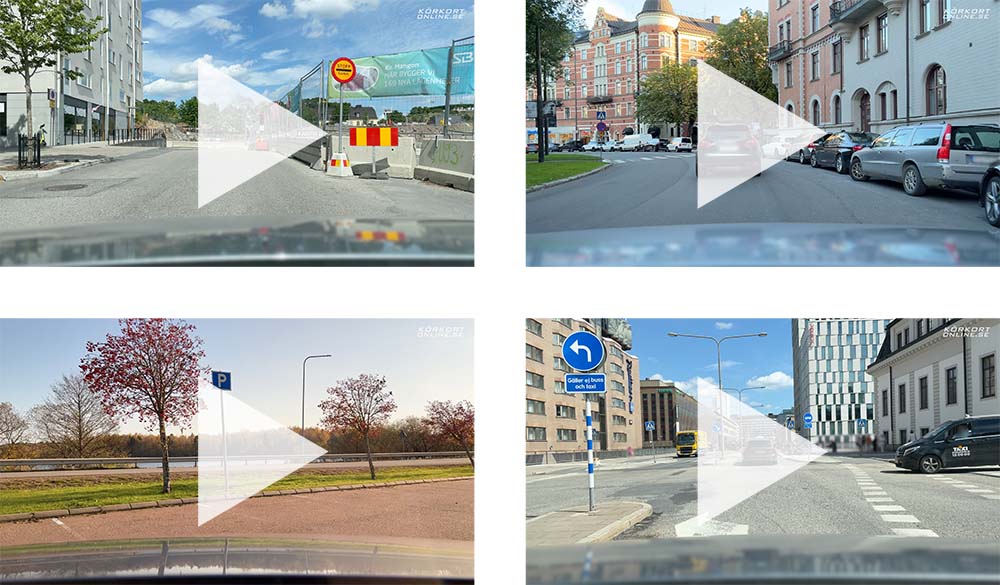Stopping distance = reaction distance + braking distance

Reaction distance
The reaction distance is the distance you travel from the point at which you detect a hazard until you begin braking or swerving.
The reaction distance is affected by
- The car’s speed (proportional increase):
- 2 x higher speed = 2 x longer reaction distance.
- 5 x higher speed = 5 x longer reaction distance.
- Your reaction time.
- Normally 0.5–2 seconds.
- 45–54-year-olds have the best reaction time in traffic.
The reaction distance can be decreased by
- Anticipation of hazards.
- Preparedness.
The reaction distance can be increased by
- The necessity of decision-making (for example, deciding whether to brake or to steer away from the hazard).
- Alcohol, drugs and medication.
- Tiredness.
Calculate the reaction distance
Easy method
Formula: Remove the last digit in the speed, multiply by the reaction time and then by 3.
Example of calculation with a speed of 50 km/h and a reaction time of 1 second:
50 km/h ⇒ 5
5 * 1 * 3 = 15 metres reaction distance
More precise method
Formula: d = (s * r) / 3.6
d = reaction distance in metres (to be calculated).
s = speed in km/h.
r = reaction time in seconds.
3.6 = fixed figure for converting km/h to m/s.
Example of calculation with a speed of 50 km/h and a reaction time of 1 second:
(50 * 1) / 3.6 = 13.9 metres reaction distance
Drive slowly or you might not even have time to react to oncoming traffic.
Braking distance
The braking distance is the distance the car travels from the point at which you begin braking until the car has come to a standstill.
The braking distance is affected by
- The vehicle’s speed (quadratic increase: “raised to the power of 2”):
- 2 x higher speed = 4 x longer braking distance.
- 3 x higher speed = 9 x longer braking distance.
- The road (gradient and conditions).
- The load.
- The brakes (condition, braking technique and how many wheels are braking).
Calculate the braking distance
It is very difficult to achieve reliable calculations of the braking distance as road conditions and the tyres’ grip can vary greatly. The braking distance may, for example, be 10 times longer when there is ice on the road.
Easy method
Conditions: Good and dry road conditions, good tyres and good brakes.
Formula: Remove the zero from the speed, multiply the figure by itself and then multiply by 0.4.
The figure 0.4 is taken from the fact that the braking distance from 10 km/h in dry road conditions is approximately 0.4 metres. This has been calculated by researchers measuring the braking distance. Thus, in the simplified formula, we base our calculations on the braking distance at 10 km/h and increase it quadratically with the increase in speed.
Example of calculation with a speed of 10 km/h:
10 km/h ⇒ 1
1 * 1 = 1
1 * 0.4 = 0.4 metres braking distance
Example of calculation with a speed of 50 km/h:
50 km/h ⇒ 5
5 * 5 = 25
25 * 0.4 = 10 metres braking distance
More precise method
Conditions: Good tyres and good brakes.
Formula: d = s2 / (250 * f)
d = braking distance in metres (to be calculated).
s = speed in km/h.
250 = fixed figure which is always used.
f = coefficient of friction, approx. 0.8 on dry asphalt and 0.1 on ice.
Example of calculation with a speed of 50 km/h on dry asphalt:
502 / (250 * 0.8) = 12.5 metres braking distance
Stopping distance
Stopping distance = reaction distance + braking distance
Calculate the stopping distance with the easy methods
It is summer and the road is dry. You are driving at 90 km/h in a car with good tyres and brakes. You suddenly notice a hazard on the road and brake forcefully. How long is the stopping distance if your reaction time is 1 second?
The stopping distance is the reaction distance + braking distance. First we calculate the reaction distance:
- 90 km/h ⇒ 9
- 9 * 1 * 3 = 27 metres reaction distance
Then we calculate the braking distance:
- 90 km/h ⇒ 9
- 9 * 9 = 81
- 81 * 0.4 = 32 metres braking distance
Now both distances are combined:
- 27 + 32 = 59 metres stopping distance
Latest forum posts
- << Vehicle terms
- Distances ↑↑
- Tyres >>



